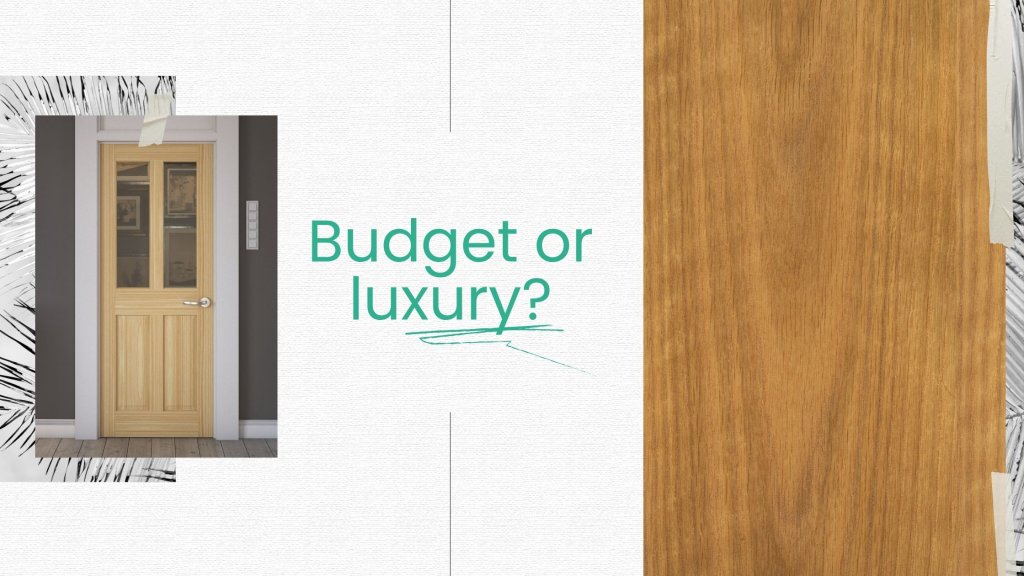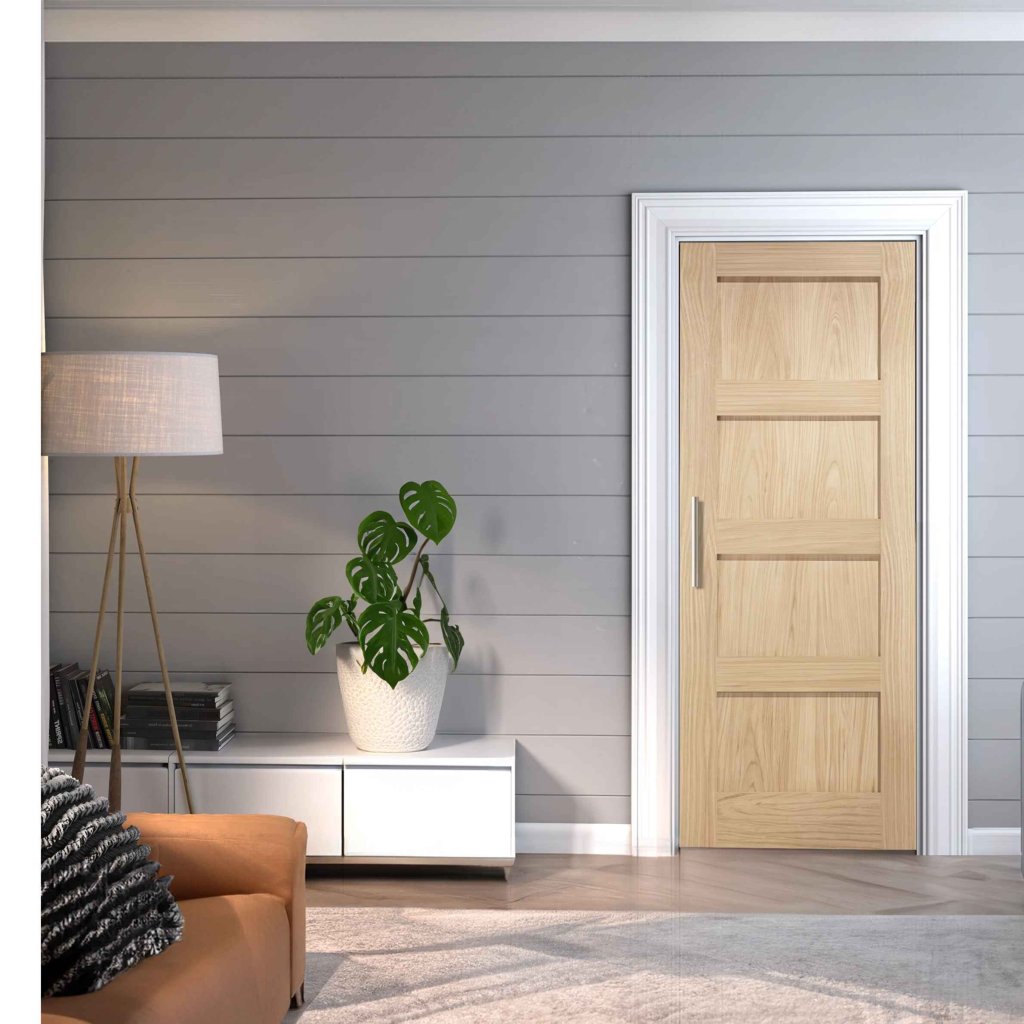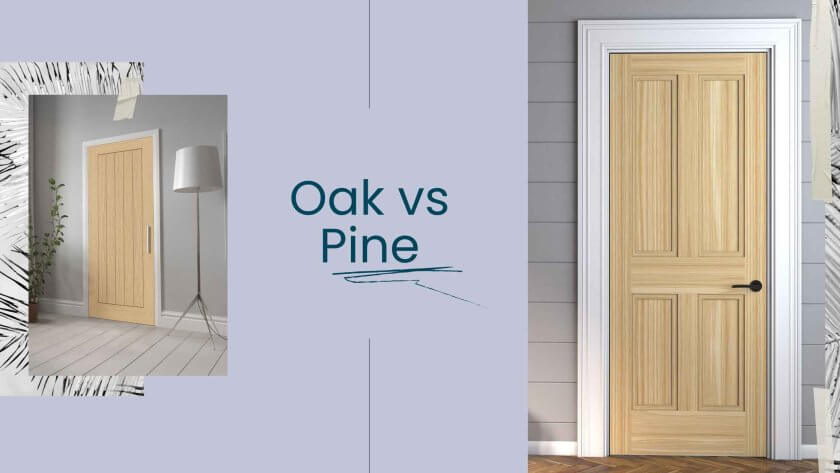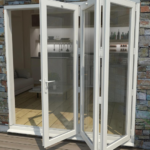When it comes to picking the right door material, two contenders usually take the spotlight: oak and pine. So, how do you choose?
In this guide, we’ll take you through the key differences between oak and pine internal doors. We’ve helped so many of our customers with the same choice over the years, so we’ve collated all the information you’ll need to choose for you here. Whether you’re renovating a period home or fitting out a modern new-build, by the end, you’ll feel informed, confident, and fully equipped to pick the door that’s right for you.
Imagine you’ve just finished planning your dream interior. The paint colours are chosen, the furniture’s been shortlisted, and now it’s time to choose your internal doors. They might not be the first thing you think of, but doors are one of the most important finishing touches in a home. They’re used daily, they’re visible in every room, and they can tie your whole look together beautifully. We’ll help you get it right. Let’s get started.
The Tale of Two Timbers: Pine and Oak Doors
Let’s start with a simple analogy. Imagine oak and pine wooden doors as two classic car types. Oak wood is your solid, stately Range Rover. It’s built to last, commanding in presence, and with a timeless quality. Oak trees grow slowly, producing a dense grain and hardy wood that should be produced sustainably.
Pine, on the other hand, is more like a reliable Ford Focus. It’s lighter, more affordable, and surprisingly versatile. Pine trees grow quickly, producing a softer wood that can still display grain patterns. Despite it’s softer nature, pine holds up well for doors, floors and furniture.

The verdict?
Both will get you where you need to go. The difference lies in the experience along the way. And ultimately, the choice is yours.
What’s the Price Difference?
Pine is generally cheaper than oak.
Pine is a softwood that grows relatively quickly, making it less expensive to source and produce. If you’re doing a whole house renovation or working to a tighter budget, pine interior doors can offer real savings without compromising on charm or function.
This is one of the biggest benefits of pine internal doors. They are a cost effective choice, giving you a great look for less. Pine doors offer a rustic country look at a really great price point.
Oak is a premium hardwood, slower-growing and denser. That’s reflected in the higher price tag. Oak internal doors tend to cost more, but for many, the investment pays off in longevity, appearance, and feel.

Our evaluation
Think of it like choosing between laminate and solid wood flooring: both serve a purpose, but the decision often comes down to how long you plan to live with it and what kind of finish you want underfoot.
For reference, at the time of writing this our solid core pine doors start from £65.88 (full price) whilst our solid core oak doors start from £84.00. (full price). This pricing does not account for sale items, so keep an eye on these too as you might find a bargain from time to time.
Durability and Longevity: Which has the Better Lifespan?
Oak wins here, hands down.
Thanks to its hardwood nature, oak is incredibly durable and is suitable for both interior and exterior doors. It resists dents and dings, handles wear and tear with grace, and can last for decades with proper care. In fact, you’ll often find original oak doors still going strong in centuries-old homes.
Pine, being softer, is more prone to scratches and knocks. That doesn’t mean it’s flimsy. It still holds up well in most domestic settings, but it may show its age a little faster, especially in high-traffic areas or busy family homes. That being said, it can still last for many years, even decades if well looked after. Pine can also be used for external doors, but they may need a little more maintenance and won’t last as long compared to oak doors.
An honest appraisal
If your home sees a lot of hustle and bustle, think muddy boots, racing toddlers, or boisterous pets, oak might be the better long-term choice. The exceptional durability of solid oak doors is difficult to match.
Yet for many homes, cost considerations can be the determining factor. The lifespan of pine doors might not be quite as expansive as oak, but it’s still more than sufficient for most.
Strength and Quality Feel
Open an oak door and you’ll feel the difference.
There’s a weightiness to it that signals strength and craftsmanship. It shuts with a satisfying thud and carries a reassuring sturdiness that many homeowners find appealing. This is particularly important if you value a sense of luxury or if your door is oversized or part of a statement piece, like a grand entrance to a home office or dining room.

Pine doors are lighter and can feel less substantial in comparison. However, many modern pine doors are engineered or solid core, which helps improve their strength and sound insulation. What’s more, lightweight doors can be easier to operate and can be helpful to those with mobility issues.
Still, if quality of feel is at the top of your list, oak takes the crown.
Appearance and Style: Which Looks Better?
This one’s subjective, but here’s what you should know.
Oak has a rich, warm grain that speaks of natural beauty and character. It can range from golden honey tones to a dark reddish brown colour. Oak suits a wide variety of interiors, from traditional cottages to contemporary spaces, and it ages beautifully, darkening slightly over time.
Pine has a lighter, more uniform appearance, with fewer knots and a paler colour. It’s great for minimalist interiors or spaces where you want the door to blend in rather than stand out.
Here’s the kicker: pine is more flexible when it comes to painting. If you’re planning to go bold with colour, pine might be your best bet. Oak, by contrast, looks best when stained or varnished to show off its natural grain.
The final word, it’s a matter of taste.


Can You Stain Pine to Look Like Oak?
Yes, but with a few caveats.
You can stain pine to mimic oak’s appearance, but pine’s softer grain takes stain differently. It often absorbs unevenly, resulting in blotchiness or dark patches unless you prepare the surface carefully. Using a wood conditioner or gel stain can help, but the end result won’t be an exact replica of real oak.
Take a look at the tired and tested tips in this video to get the right look:
If you’re set on that oak look but working with a pine budget, this is an option. Just be prepared for a bit more prep work and a potentially imperfect match.
How to Tell the Difference Between Oak and Pine
If you’re shopping in person or trying to identify an existing door, here are a few clues:
- Grain: Oak has a coarse, prominent grain with visible swirls and patterns. Pine has a smoother, straighter grain, often with small knots.
- Weight: Oak doors are noticeably heavier than pine.
- Colour: Oak tends to be darker and richer; pine is lighter and creamier in tone.
- Hardness: Knock on the wood. Oak gives a denser, deeper sound. Pine feels lighter and slightly more hollow.
Choosing the Right Door for Your Space
Let’s get practical. Here are a few common scenarios, along with the best choice of new doors for each:
- You’re renovating a character property: Go for oak. It will complement the period features and last for years.
- You’re doing up a rental or starter home: Pine might be perfect. It’s affordable, functional, and easy to refresh with a lick of paint.
- You’ve got kids or pets: Oak’s durability will stand up to knocks, scuffs, and everyday chaos.
- You love to redecorate: Pine offers more flexibility if you’re likely to repaint or restyle frequently.
Final Thoughts: Feel Empowered to Choose
Choosing between oak and pine internal doors isn’t just a matter of cost. It’s about lifestyle, taste, and long-term value.
Oak is for those seeking timeless beauty, enduring quality, and that solid, satisfying feel.
Pine is for those who want affordability, versatility, and a lighter, more adaptable look.
Both materials have their merits. What matters most is finding the right fit for you. After all, it’s your home, your family, your vision.
So whether you’re opening a door to the nursery, a home office, or your own personal sanctuary, now you’ve got the benefit of years worth of knowledge so you can choose with confidence.
And after all, every door you walk through should feel like home.





